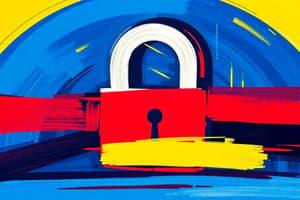Podcast
Questions and Answers
What process is used to filter out packets sent to specific logical ports?
What process is used to filter out packets sent to specific logical ports?
- Network address translation
- Data encryption
- Packet filtering (correct)
- IP address blocking
What is the primary purpose of antivirus software?
What is the primary purpose of antivirus software?
- To detect and protect against viruses (correct)
- To block advertisements
- To enhance internet speed
- To manage hardware resources
What does the term 'virus signature' refer to?
What does the term 'virus signature' refer to?
- The name of the antivirus program
- The main function of the antivirus software
- A type of malware that spreads rapidly
- A portion of the virus code unique to a specific virus (correct)
Which type of attack affects a small percentage of web pages by exploiting weaknesses in systems?
Which type of attack affects a small percentage of web pages by exploiting weaknesses in systems?
How can you minimize the risk of malware attacks on your operating system?
How can you minimize the risk of malware attacks on your operating system?
What is the recommended length for creating strong passwords?
What is the recommended length for creating strong passwords?
Which of the following devices reads unique personal characteristics for authentication?
Which of the following devices reads unique personal characteristics for authentication?
What does 'quarantining' mean in relation to viruses?
What does 'quarantining' mean in relation to viruses?
What is spyware primarily designed to do?
What is spyware primarily designed to do?
What is phishing aimed at achieving?
What is phishing aimed at achieving?
What function does a firewall serve?
What function does a firewall serve?
Which of the following describes scareware?
Which of the following describes scareware?
What technique involves creating a seemingly legitimate scenario to deceive users?
What technique involves creating a seemingly legitimate scenario to deceive users?
Which of the following is an effect of cookies?
Which of the following is an effect of cookies?
What is pharming primarily aimed at?
What is pharming primarily aimed at?
What can spam filters do?
What can spam filters do?
Which of the following is included in comprehensive Internet security software packages?
Which of the following is included in comprehensive Internet security software packages?
Which is NOT a recommended guideline to avoid phishing scams?
Which is NOT a recommended guideline to avoid phishing scams?
What is the primary purpose of a computer virus?
What is the primary purpose of a computer virus?
Which type of virus is triggered by a specific date or time?
Which type of virus is triggered by a specific date or time?
What distinguishes a polymorphic virus?
What distinguishes a polymorphic virus?
Which of the following is NOT a characteristic of a DDoS attack?
Which of the following is NOT a characteristic of a DDoS attack?
What is the function of adware?
What is the function of adware?
Which type of malware replicates itself without needing a host file?
Which type of malware replicates itself without needing a host file?
What does a logic bomb do?
What does a logic bomb do?
Which type of virus attempts to evade detection by erasing code temporarily?
Which type of virus attempts to evade detection by erasing code temporarily?
How can e-mail viruses propagate?
How can e-mail viruses propagate?
What is the main purpose of ransomware?
What is the main purpose of ransomware?
What is the main purpose of a keylogger?
What is the main purpose of a keylogger?
What type of hacker primarily aims to destroy information or gain illegally?
What type of hacker primarily aims to destroy information or gain illegally?
What characterizes a Trojan horse in the context of cybersecurity?
What characterizes a Trojan horse in the context of cybersecurity?
What does identity theft commonly involve?
What does identity theft commonly involve?
What is the role of a packet analyzer in hacking?
What is the role of a packet analyzer in hacking?
How is a zombie computer commonly used in cybercrime?
How is a zombie computer commonly used in cybercrime?
What is a common social engineering technique used by cybercriminals?
What is a common social engineering technique used by cybercriminals?
What distinguishes white-hat hackers from other types of hackers?
What distinguishes white-hat hackers from other types of hackers?
Which type of malware pretends to be a legitimate program while performing malicious activities?
Which type of malware pretends to be a legitimate program while performing malicious activities?
What is the primary function of antivirus software?
What is the primary function of antivirus software?
Flashcards
Firewall Packet Filtering
Firewall Packet Filtering
A firewall technique that blocks packets destined for specific ports.
Firewall Port Blocking
Firewall Port Blocking
A firewall technique that completely rejects requests for specific ports from the internet.
Network Address Translation (NAT)
Network Address Translation (NAT)
A firewall process that assigns internal IP addresses on a network.
Antivirus Software
Antivirus Software
Signup and view all the flashcards
Virus Signature
Virus Signature
Signup and view all the flashcards
Quarantine (Virus)
Quarantine (Virus)
Signup and view all the flashcards
Strong Passwords
Strong Passwords
Signup and view all the flashcards
Biometric Authentication
Biometric Authentication
Signup and view all the flashcards
Drive-by Download
Drive-by Download
Signup and view all the flashcards
Operating System Updates
Operating System Updates
Signup and view all the flashcards
Spyware definition
Spyware definition
Signup and view all the flashcards
Spam definition
Spam definition
Signup and view all the flashcards
Cookies definition
Cookies definition
Signup and view all the flashcards
Social Engineering definition
Social Engineering definition
Signup and view all the flashcards
Phishing definition
Phishing definition
Signup and view all the flashcards
Scareware definition
Scareware definition
Signup and view all the flashcards
Firewall definition
Firewall definition
Signup and view all the flashcards
Antivirus protection purpose
Antivirus protection purpose
Signup and view all the flashcards
Pretexting definition
Pretexting definition
Signup and view all the flashcards
Pharming definition
Pharming definition
Signup and view all the flashcards
Botnet
Botnet
Signup and view all the flashcards
DDoS Attack
DDoS Attack
Signup and view all the flashcards
Exploit Kit
Exploit Kit
Signup and view all the flashcards
Virus
Virus
Signup and view all the flashcards
Boot-Sector Virus
Boot-Sector Virus
Signup and view all the flashcards
Logic Bomb
Logic Bomb
Signup and view all the flashcards
Time Bomb
Time Bomb
Signup and view all the flashcards
Worm
Worm
Signup and view all the flashcards
Polymorphic Virus
Polymorphic Virus
Signup and view all the flashcards
Malware
Malware
Signup and view all the flashcards
Cybercrime
Cybercrime
Signup and view all the flashcards
Identity Theft
Identity Theft
Signup and view all the flashcards
What is a hacker?
What is a hacker?
Signup and view all the flashcards
White-hat hacker
White-hat hacker
Signup and view all the flashcards
Black-hat hacker
Black-hat hacker
Signup and view all the flashcards
Trojan Horse
Trojan Horse
Signup and view all the flashcards
Backdoor program
Backdoor program
Signup and view all the flashcards
Zombie
Zombie
Signup and view all the flashcards
Denial-of-service attack
Denial-of-service attack
Signup and view all the flashcards
Packet analyzer
Packet analyzer
Signup and view all the flashcards
Study Notes
Technology in Action - Chapter 9
- Chapter title: Securing Your System: Protecting Your Digital Data and Devices
- Cybercrime is any criminal activity primarily done using computers.
- Cybercriminals are individuals who use computers, networks, and the Internet to commit crimes.
- Four common complaints include FBI-related scams, identity theft, non-delivery of merchandise, and advance-fee fraud.
- Other serious complaints include computer intrusions, hacking, child pornography, and blackmail.
Identity Theft and Hackers
- Cybercrime is a criminal action done primarily through a computer.
- Cybercriminals are individuals utilizing computers for crime.
- Common cybercrime types: FBI-related scams, identity theft, non-delivery of merchandise, and advance-fee fraud.
- Other types include computer intrusions, hacking, child pornography, and blackmail.
Identity Theft
- Identity theft occurs when a thief assumes your identity.
- It's the most financially damaging form of cybercrime.
- Examples of scams during identity theft: -Counterfeiting credit/debit cards -Requesting address changes -Creating new credit accounts -Getting medical services -Buying a home and reselling it
Hacking
- A Hacker is someone breaking into a computer system.
- Types of hackers: -White-hat hackers–use hacking for ethical testing -Black-hat hackers– use hacking for illegal gain -Grey-hat hackers– use hacking to showcase their skills
Hacking (continued)
- Packet analyzer (sniffer) is a program deployed to examine network traffic.
- Keylogger is a program capturing keystrokes.
Hacking (continued)
- Trojan horses are programs appearing as helpful but maliciously execute code in the background.
- Backdoor programs and rootkits give hackers access without user knowledge.
Hacking (continued)
- A Zombie computer is controlled by a hacker for denial-of-service attacks.
- Denial-of-service attacks make legitimate users inaccessible by flooding requests to a computer system.
- DDoS (Distributed Denial-of-Service) attacks are launched from multiple zombies simultaneously.
- A botnet is a large group of zombie computers.
Hacking (continued)
- Exploit kits are programs located on servers, designed to detect and exploit system vulnerabilities.
- Logical ports are virtual, not physical, communications paths.
Computer Viruses
- A virus attaches to a program to spread to other computers.
- The main function is to duplicate itself in many files.
- Consequences may range from annoying pop-ups to file deletion.
- Viruses can infect smartphones and tablets
Computer Viruses (continued)
- Viruses can be categorized as: -Boot-sector viruses -Logic bombs/time bombs -Worms -Script/macro viruses -Email viruses -Encryption viruses
Computer Viruses (continued)
- Classification methods for virus avoidance: -Polymorphic viruses change their code periodically -Multi-partite viruses infect multiple file types -Stealth viruses hide in active memory by erasing their code
Online Annoyances and Social Engineering
- Malware is software with malicious intent. -Adware displays advertisements -Spyware collects information and runs in the background -Keystroke logger records keystrokes
- Spam is unwanted email. -Spam filters are tools to limit spam.
Online Annoyances and Social Engineering (continued)
- Cookies are small text files stored on your computer when you visit websites.
- Websites use cookies to understand user activity and effectiveness of marketing efforts.
- Cookies don't directly harm your computer.
Online Annoyances and Social Engineering (continued)
- Social engineering utilizes social skills to gain information from individuals.
- Pretexting is impersonation.
Online Annoyances and Social Engineering (continued)
- Phishing is tricking individuals into revealing personal information by pretending to be a trustworthy entity.
- Pharming plants malicious code on computers to gain information.
- Guidelines to avoid scams include avoiding email requests for information and verifying from the company directly.
- Use secure sites, phishing filters, and updated internet security software.
Online Annoyances and Social Engineering (continued)
- Scareware is malware that tries to convince you of a problem and get you to pay for a solution.
Restricting Access to Your Digital Assets: Firewalls
- A firewall is a software or hardware that protects your computer from hackers.
- Windows and macOS include firewalls.
- Firewalls use packet filtering, logical port blocking, and network address translation to control network traffic.
Restricting Access to Your Digital Assets: Preventing Virus Infections
- Antivirus software detects and protects your computer from viruses.
- Popular antivirus programs include Symantec, Trend Micro, and Avast.
- Virus signatures are unique codes used to identify specific viruses.
- Quarantining isolates infected files.
- Inoculation records key attributes of files.
- Keeping your operating system updated can prevent drive-by download attacks.
Restricting Access to Your Digital Assets: Authentication
- Strong passwords should have at least eight characters with a combination of uppercase, lowercase, numbers, and symbols.
- Biometric authentication devices use unique physical characteristics like fingerprints, iris scans, and facial recognition.
Studying That Suits You
Use AI to generate personalized quizzes and flashcards to suit your learning preferences.




